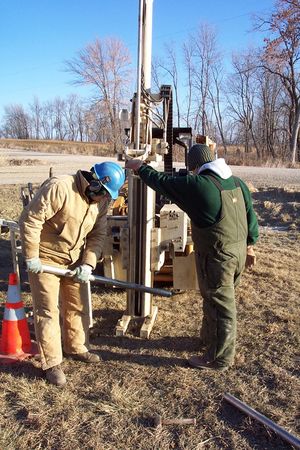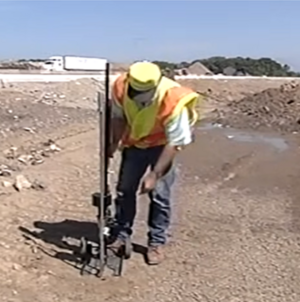
Soil sampling and tests
There are hundreds of soil tests that can be conducted, both in the field or laboratory. This page provides an overview of more common soil tests, links to information on sampling, and links to test methods.
Contents
Sample collection
Soil sample collection methods vary and covering all acceptable methods is beyond the scope of this page. Below are links to sampling methods, including videos.
Documents
- US EPA - focus on VOCs and PFAS
- Testing Your Soil Why and How to Take a Soil-Test Sample - University of Hawaii
- Sampling Soils for Nutrient Management - USDA-NRCS; focus on phosphorus
- Procedure for taking soil samples - Stephen F. Austin State University
- Soil Sampling Testing - USDA-NRCS
- Soil Sampling Guidelines - Purdue University
- Composite Soil Sampling - MCSE - Kellogg Biological Station
- Soil sample collection and analysis procedures - MPCA Petroleum Remediation Program
- Sampling and Analysis Plan Midland Plant and Salzburg Landfill
- Soil Sampling Quality Assurance User's Guide - US EPA
Videos of sample collection for lab analysis
- How to Collect a Soil Sample for Lab Analysis
- Collecting Soil Samples: Part 1 - Tools, Part 2 - Sample collection
- How to Take a Soil Sample
Chemical tests
Most chemical tests are conducted in the laboratory on samples collected in the field.
Recommended holding times and preservation
Nutrients
For more information link here.
Soil macronutrients include phosphorus, nitrogen, potassium, sulfur, calcium, and magnesium. Phosphorus is an important pollutant of concern in surface water, particularly lakes. Though there are several forms of phosphorus, they can roughly be divided into dissolved phosphorus (includes orthophosphate and soluble phosphorus) and particulate phosphorus, with dissolved phosphorus being much more bioavailable than particulate forms. Dissolved phosphorus is typically identified as phosphorus passing through a 0.45 micron filter. For a detailed discussion of phosphorus, link here.
Nitrogen is also an important nutrient in both surface water and groundwater. Nitrogen concentrations in stormwater are typically below levels of concern for receiving waters.
Potassium, sulfur, calcium, and magnesium are typically not pollutants of concern in stormwater runoff, but they may be deficient in some soils and therefore potentially impact vegetation.
- Phosphorus
- Bray Method: use on acidic and neutral soils
- Olsen Method: preferred on high pH soils
- Mehlich-3 Method: provides a better indicator of plant-available phosphorus
- Nitrogen
- Potassium, Sodium, Calcium, Magnesium, Boron and sulfate-Sulfur
- Inductively Coupled Plasma Emission Spectrometry (ICP-AES) - recommended due to lower detection limits, but more expensive
- Atomic absorption spectroscopy
Metals
The primary sources of metals in stormwater runoff are associated with automobiles, both from fluids and wear of parts, including tires. Concentrations of metals in stormwater runoff are generally below aquatic life and drinking water criteria, though concentrations may exceed criteria for sensitive species and in specific land uses, such as high traffic transportation areas. Metals of greatest concern include copper, zinc, nickel, cadmium, and lead.
Samples are typically collected for total metals, meaning samples are not filtered. For dissolved metal concentrations, samples are filtered using a 0.45 micron filter. From an environmental perspective, dissolved metal concentrations more accurately reflect potential risk to receptors, since most metal bound to particles is retained in stormwater bmps. Lab methods include the following.
- Inductively Coupled Plasma Emission Spectrometry (ICP-AES) - recommended due to lower detection limits, but more expensive
- Atomic absorption spectroscopy
pH
Soil pH typically ranges from 6 to 8. Soils with elevated organic matter concentrations may have lower pH. Soil pH affects biologic activity and chemical reactions, particularly of some metals. Soil pH is generally not a concern, though some amendments, such as lime (increases pH), may lead to soil pH values that adversely affect soil biology, vegetation, mobilize metals, or bind up nutrients. Recommended lab methods include the following.
- Saturated paste - recommended
- 1:1 and 2:1 water ratios
Organic matter and carbon
By itself, organic matter is not generally a pollutant of concern unless it contains bound pollutants at levels of concern (e.g. metals, organic pollutants such as oil and pesticides). Organic matter can create oxygen demand in receiving waters and, as mentioned above, transport attached chemicals that may become a concern in receiving waters, including nutrients, metals , and organic pollutants. Organic matter also provides a food source for bacteria and pathogens.
- organic carbon combustion
- organic matter Walkley-Black
- Organic matter loss on ignition - recommended due to ease of use and since organic matter is more commonly used compared to organic carbon
Exchange capacity
Exchange capacity affects the fate of other soil chemicals, including nutrients and pollutants, and provides a buffer against soil acidification.
- Cation exchange capacity - multiple methods are available for cation exchange capacity. For more information read here.
- Barium chloride Compulsive Exchange Method - recommended but is time consuming and generates a hazardous waste
- Ammonium Acetate Method - acceptable if soil pH is near 7.0
- Agronomic Soil Tests - estimates CEC from test extractable Ca, K, and Mg and some rapid measure of exchangeable acidity (see next bullet)
- Exchangeable Potassium, Calcium, Magnesium, Sodium And Estimated Cation Exchange Capacity
Enzyme activity
Enzymes in soil mediate numerous chemical reactions involved in soil nutrient cycling, transformation of plant and microbial debris, mineralization and transformation of organic matter within the carbon cycle, and transformation and degradation of potentially hazardous pollutants.
- Fluorescence assays - synthetic C-, N-, or P-rich substrates bound with a fluorescent dye are added to soil samples. When intact, the labeled substrates do not fluoresce. Enzyme activity is measured as the increase in fluorescence as the fluorescent dyes are cleaved from their substrates, which allows them to fluoresce. Enzyme measurements can be expressed in units of molarity or activity. See this article and associated video for a description of the method.
- Spectrophotometric assays - the course of the enzymatic reaction is followed by measuring a change in how much light the assay solution absorbs
- Calorimetric assays - measure the heat released or absorbed by chemical reactions. These assays are very general.
- Radiometric assays - measure the incorporation of radioactivity into substrates or its release from substrates. These assays are both extremely sensitive and specific.
- Chromatographic assays - measure product formation by separating the reaction mixture into its components by chromatography. This is usually done by high-performance liquid chromatography (HPLC), but can also use thin layer chromatography.
Specific recommended procedures are not provided as there is a wide range of methods depending on objectives of the sampling. This video provides a discussion of enzymes and soil enzymes, including sample collection and measurement (starting at about the 39 minute mark). This website provides a discussion of soil enzymes including limitations of testing methods. Additional references include the following.
- Soil enzyme - Ward Laboratory
- Emerging tools for measuring and modeling the in situ activity of soil extracellular enzymes
Field methods
Field methods for soil chemical testing are generally not recommended, though they can be useful in providing general information. Typically field tests involve the use of test strips or probes. Portable laboratories can be used to conduct some of the analyses described above. Although these tests are conducted in the field, they utilize laboratory methods and are therefore more appropriately considered lab tests.
Here are some links to information on soil chemical field tests.
- Soil respiration (Solvita test)
- An automated system for rapid in-field soil nutrient testing
- Gardening centers typically provide information on field tests (e.g. for home gardens), with nutrients being the primary focus
Tests for soil physical and hydrologic properties
Most soil physical and hydrologic tests can be done in the field, but some require additional procedures performed in the laboratory.
Soil water (moisture) content
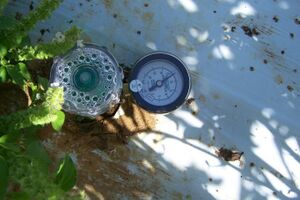
Laboratory analysis of soil water content is recommended for point-in-time measurements. Lab methods involve weighing a soil sample prior to drying, then drying to constant weight in oven at temperature between 100–110oC (105oC is typical). The difference in weight represents the mass of water in the sample. The water content is then expressed on a mass basis (g of water to g of dry soil), or if the bulk density is known, the volume of water to volume of soil. It is important that samples collected in the field be properly stored to avoid water loss prior to analysis. For further reading see [4].
For continuous measurements, field methods must be employed. Field methods are summarized below. The most common methods are electrical resistance (e.g. time domain reflectometry), tensiometric, and radioactive (e.g. neutron probe). This document and this document provide discussions of methods for measuring soil water content. This one hour video provides an overview of soil water measurement.
- Electrical-resistance
- Heat-diffusion Reference (see Section C)
- Absorption Reference (see Section D)
- Tensiometric
- Penetration Reference (see Section F)
- Radioactive
Available water capacity
Available water capacity is the maximum amount of plant available water a soil can provide, often calculated as water available between field capacity and the wilting point.
This link provides a discussion of methods for determining available water capacity.
- Soil water – methods to predict plant available water capacity (PAWC) using soil-landscape associations
- A New Method for Measuring Plant Available Water Capacity Helps Document Benefits of Biochar-Soil Mixtures
- Video: Soil Available Water Capacity Demonstration
- Video: Soil Water Holding Capacity Determination Practical Experiment
- Video: Calculating Plant Available Water
Bulk density
Soil bulk density is an important measurement for determining soil infiltration and plant rooting properties. Measuring bulk density involves proper sample collection and laboratory analysis. Below are links to videos demonstrating methods for collecting bulk density samples.
- Bulk density and soil water (moisture) content - a 12 minute video illustrating how to collect the sample in field and measure in the lab using the core method
- Bulk density and soil water (moisture) content - a 10 minute video using the core method
- Bulk density and soil water (moisture) content - this 34 minute video describes the clod method, which is preferred but more time consuming and cannot be used for soils where intact clods cannot be collected
Methods for measuring bulk density are provided in the following documents.
Infiltration rate
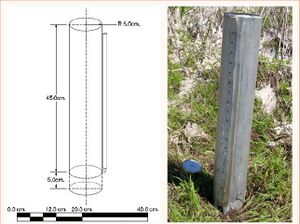
Infiltration rates should be measured in the field. This page provides information on measuring soil infiltration rates.
Videos illustrating measurement of infiltration rates.
- Modified Philip-Dunne permeameter
- Guelph permeameter
- Double ring infiltrometer
- Double ring infiltrometer
Compaction (penetration resistance)
Soil compaction results from repeated traffic, generally from machinery, or repeated tillage at the same depth, which results in a compacted layer at the tillage depth. Compaction inhibits infiltration, gas and water movement, may impede root growth, disrupts habitat for soil biota, and affects nutrient cycling. There are several field methods for determining soil compaction or penetration resistance.
- Sand Cone Method: The sand cone test is a relatively simple test that doesn't take long to perform, but does require drying soil samples. It is not suitable for saturated and soft soils. The method consists of digging a hole in a soil, determining the volume of the hole by filling the whole with sand of known dry density, determining the dry density of the soil removed from the whole, and computing percent compaction. The procedure is described in this video. This worksheet can be used to make the calculations. Calculations and procedures are also shown on this website.
- Rubber balloon method: Rubber Balloon Density test are similar to the sand cone method. A balloon density apparatus is positioned over the hole, and instead of using sand to measure volume, the calibrated water vessel is pressurized, forcing a rubber membrane into the excavation. Graduations on the vessel are read to determine the amount of water displaced so the whole volume can be calculated. The test method is described in ASTM D2167 / AASHTO T 205 (withdrawn). The tests simpler to perform than the sand cone and can be repeated quickly since the water is retained in the vessel. Reference.
- Penetrometers: Penetrometers measure the force needed to push a metal rod of known diameter into a growing medium. They may be hand operated or machine driven. The cone penetrometer, the most commonly used penetrometer, simulates a root growing through the soil. A hand operated unit is pushed into a soil and a gauge on the device measures the amount of force needed to penetrate the soil. These videos ([5], [6], [7]) demonstrate how to use penetrometers in the field. While easy to use, there are some limitations. Measurements should be made when the soil is near field capacity. The device may have limitations in granular soils, clay soils, and soils with sharp boundary layers. For more information, including procedure descriptions and equipment needs, see [8], [9], and [10].
- Nuclear test: Nuclear density gauges determine soil density by measuring gamma radiation transmission between a probe containing a radioactive Cesium 137 (or other) source and detection sensors in the base of the gauge. Dense soils allow fewer gamma particles to be detected in a given time period. Soil moisture is measured at the same time. Nuclear density gauges are efficient on large projects requiring rapid results and multiple tests but are subject to regulatory requirements and require advanced training and radiation dosage monitoring of personnel. Test methods are described in ASTM D6938 / AASHTO T 310.
For additional information on measuring soil compaction, see [11], [12], and [13].
Aggregate stability
Non-granular soils (e.g. clays) form aggregates that are important in maintaining soil physical, chemical, and biologic processes. Methods for assessing aggregate stability are somewhat qualitative and different methods do not correlate well. The method selected should simulate field processes likely to affect aggregate stability (e.g. rainfall impact, ponded (flooded) conditions, tillage).
- Sieve or strainer method: The most commonly used method for testing aggregate stability involves placing a soil sample on a nest of soil sieves with screen sizes typically ranging from 1 mm to 45 microns and then moving this nest of sieves up and down in a bucket of water. The more stable aggregates will stay on the top sieve, while less stable aggregates will move through the larger sieves to the finer sieves. Soil stability is assessed by measuring the mass of soil remaining, as a percent of initial soil mass, on the sieve after a specified number of dipping cycles (e.g. 5 cycles). Soils with high aggregate stability will typically retain 50 percent or more of the initial soil mass. This method may represent stability under rainfall.
- Slake test: Dried aggregates are placed into a container filled with water. Assess the aggregates after specified times (e.g. 20 minutes, 2 hours, 20 hours). This method may represent stability under flooded (water immersed) conditions.
- Vibration methods: An ultrasonic probe immersed in water containing soil aggregates vibrates at different vibration amplitudes. Soil stability is assessed after specific time intervals. This method may represent stability under tillage conditions.
Further reading
- Field soil aggregate stability kit for soil quality and rangeland health assessments
- Assessing soil aggregate stability
- Evaluation of methods for determining soil aggregate stability
- Characterization of soil aggregate stability using low intensity ultrasonic vibrations
- Soil aggregate stability
Videos
Texture
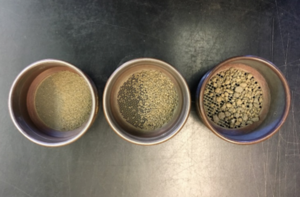
Soil texture is determined with one of the following methods.
- Mechanical sieving, if particle size > 0.05 mm (Reference)
- Sedimentation if size < 0.05 mm. Sedimentation measures the settling rate of particles in liquid medium and relates this rate to the particle mass by use of the Stoke's Law. Forces acting on soil particle are gravitation, buoyancy and drag forces, all of which depend on particle size. Larger particles settle first. The particle mass is determined by density and particle size. Soils must be dispersed prior to measurement. Two methods are commonly used.
- Hydrometer method (see here for description)
- Pipette method (see this video for a description)
Other methods, which employ qualitative approaches, include the feel method, ball and ribbon methods, and ball throwing method. These are described here.
Soil structure
Measurement of soil structure typically focuses on determining soil stability and texture. See the methods above for measuring these properties. Additional references and links are provided below.
- Video: How to test soil structure
- Video: How to determine soil structure
- The measurement of soil structure - Some practical initiatives
- How to test soil structure
- Soil Texture and Structure
- A method for assessing soil structure
Surface crusting
Structural soil crusts are relatively thin, dense, somewhat continuous layers of non-aggregated soil particles on the surface of tilled and exposed soils. A surface crust indicates poor infiltration, a problematical seedbed, and reduced air exchange between the soil and atmosphere. It can also indicate that a soil has a high sodium content that increases soil dispersion when it is wetted by rainfall or irrigation. Tests typically are based on applying pressure to determine the strength of a crust, or methods to determine stability of the surface crust.
Below are resources for measuring soil crusting and strength of crusts.
- Video: SoilHealth Trainings 4: Surface Crusts (Surface Crusting)
- Using the Slake Test to Determine Soil Crusting
- Soil crust strength measurement
- A technique for measuring soil crust strengths
- Soil Quality Indicators: Soil Crusts
Macroporosity
In soils with significant macroporosity, a high percentage of annual water and solute movement can occur within the macropores. This can lead to rapid movement of solutes, including pollutants of concern, deep into the soil profile and eventually into groundwater. Soil macroporosity can be measured directly in the field by physically excavating soil, typically in layers, and quantifying soil macropores. Colored or fluorescent dyes are often used, as well as imaging equipment. Examples of this methodology are provided at the following links.
- An Improved Method for Quantifying Soil Macroporosity
- Quantification of soil macroporosity and its relationship with soil properties
- Revealing Soil Structure and Functional Macroporosity along a Clay Gradient Using X-ray Computed Tomography
- THE CHARACTERIZATION OF SOIL MACROPOROSITY WITH CT SCANNING
Macroporosity can also be estimated using indirect methods, such as those based on bulk density, water content, particle size distribution, and infiltration. Examples are provided at the following links.
- METHOD TO ESTIMATE SOIL MACROPOROSITY AND MICROPOROSITY BASED ON SAND CONTENT AND BULK DENSITY
- The determination of the macroporosity of impregnated blocks of a clay soil and its relation to volumetric water content
- Estimating Macroporosity in a Forest Watershed by use of a Tension Infiltrometer
- Quantitative Relationships between Soil Macropore Characteristics and Preferential Flow and Transport
- Effect of Macroporosity on Pedotransfer Function Estimates at the Field Scale
Biotic diversity
There are currently two types of tests that can be performed to determine soil diversity: Tests that analyze and classify parts of the microbial material itself (‘taxonomic tests’), and tests that look at the metabolic products of microbes (‘functional tests’). Below are links to websites and videos that provide information on testing for biotic diversity, including testing methods.
- How can we measure soil biodiversity: Provides a discussion of approaches to measuring soil biotic diversity
- SoilBio soil health test
- Biological soil tests
- Soil Biological tests
- Standardisation of methods in soil microbiology: progress and challenges
- Soil microbial diversity: Methodological strategy, spatial overview and functional interest
- Methods of studying soil microbial diversity
- Soil Lab Test Series #1: Soil Biodiversity Testing: Provides links to sites that offer testing
- Videos
This page was last edited on 11 January 2023, at 14:39.

